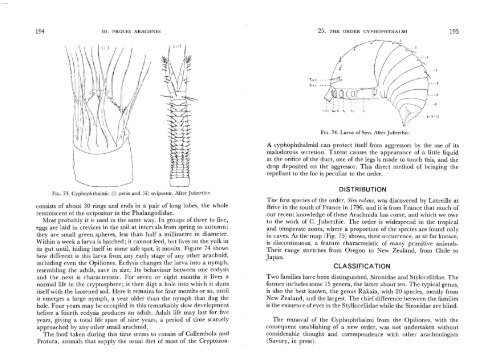You also want an ePaper? Increase the reach of your titles
YUMPU automatically turns print PDFs into web optimized ePapers that Google loves.
194 III. PROLES ARACIINES<br />
25. THE ORDER CYPHOPHTHALMI 195<br />
FIG. 74. Larva of Siro. After Juberthie.<br />
A cyphophthalmid can protect itself from aggressors by the use of its<br />
malodorous secretion. Threat causes the appearance of a little liquid<br />
at the orifice of the duct, one of the legs is made to touch this, and the<br />
drop deposited on the aggressor. This direct method of bringing the<br />
repellant to the foe is peculiar to the order.<br />
FIG. 73. Cyphophthalmi: (i) penis and (ii) ovipostor. Mter Juberthie.<br />
consists of about 30 rings and ends in a pair of long lobes, the whole<br />
reminiscent of the ovipositor in the Phalangodidae.<br />
Most probably it is used in the same way. In groups of three to five,<br />
eggs are laid in in the soil at intervals from spring to autumn:<br />
they are small green spheres, less than half a millimetre in diameter.<br />
w-ithin a week a larva is hatched; it cannot feed, but lives on the yolk in<br />
its gut until, hiding itself in some safe spot, it moults. Figure 74 shows<br />
how different is this larva from any early stage of any other arachnid,<br />
including even the Opiliones. Ecdysis changes the larva into a nymph,<br />
resembling the adult, save in size. Its behaviour between one ecdysis<br />
and the next is characteristic. For seven or eight months it lives a<br />
normal life in the cryptosphere; it then digs a hole into which it shuts<br />
itself with the loosened soil. Here it remains for four months or so, until<br />
it emerges a large nymph, a year older than the nymph that dug the<br />
hole. Four years may be occupied in this remarkably slow development<br />
before a fourth ecdysis produces an adult. Adult life may last for five<br />
years, giving a total life span of nine years, a period of time scarcely<br />
approached by any other small arachnid.<br />
The food taken during this time seems to consist of Collembola and<br />
Protura, animals that supply the usual diet of most of the Cryptozoa.<br />
DISTRIBUTION<br />
The first species of the order, Siro rubens, was discovered by Latreille at<br />
Brive in the south of France in 1796, and it is from France that much of<br />
our recent knowledge of these <strong>Arachnida</strong> has come, and which we owe<br />
to the work of C. Juberthie. The order is widespread in the tropical<br />
and temperate zones, where a proportion of the species are found only<br />
in caves. As the map (Fig. 75) shows, their occurrence, as so far known,<br />
is discontinuous, a feature characteristic of many primitive animals.<br />
Their range stretches from Oregon to New Zealand, from Chile to<br />
Japan.<br />
CLASSIFICATION<br />
Two families have been distinguished, Sironidae and Stylocellidae. The<br />
former includes some 15 genera, the latter about ten. The typical genus,<br />
is also the best known, the genus Rakaia, with 20 species, mostly from<br />
New Zealand, and the largest. The chief difference between the families<br />
is the existence of eyes in the Styllocellidae while the Sironidae are blind.<br />
The removal of the Cyphophthalmi from the Opiliones, with the<br />
consequent establishing of a new order, was not undertaken without<br />
considerable thought and correspondence with other arachnologists<br />
(<strong>Savory</strong>, in press).















